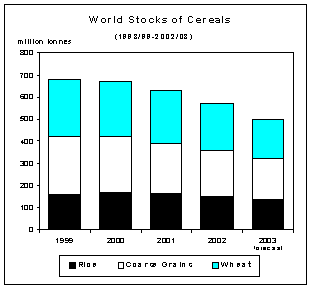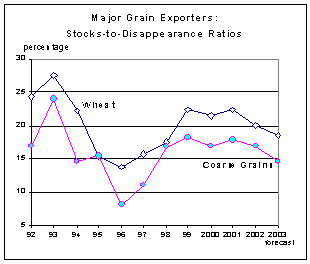World cereal stocks by the end of the crop seasons in 2003 are likely to fall again, to 498 million tonnes, down 72 million tonnes, or 13 percent, from their already reduced opening levels and 17 million tonnes lower than was reported in May. The revision is largely due to a cut of 25 million tonnes in the forecast for global cereals production in 2002. At the global level, the anticipated decline in wheat inventories would be the most significant, but coarse grains and rice stocks are also likely to fall sharply.

The primary factor for successive years of global stocks depletion continues to hinge on developments in China, where, following a period of large stocks, the Government is pursuing downsizing strategies, underlying its commitment to market reform. While cereal stocks in China could remain bountiful for at least a few more years, based on FAO’s latest forecasts, closing cereal stocks in China would be 45 million tonnes lower than at the start of the season and nearly 40 percent, or 150 million tonnes, smaller than only four years ago.
World wheat stocks by the close of the seasons ending in 2003 are now forecast to reach 174 million tonnes, around 35 million tonnes, or 17 percent, below their opening levels. The sharp anticipated decline in this year’s wheat production in China coupled with the country’s aim to lower its inventories would result in another large drop in its wheat stocks, to 62 million tonnes, or down 24 million tonnes from the previous season. Lower wheat stocks are also anticipated in several eastern European and CIS countries as their exports are likely to remain large and their overall production slightly reduced. By contrast, in India, where this year’s wheat crop will again be above-average, total inventories would remain above the Government’s target level and could even increase should exports remain below the current expectation.

Total wheat stocks held by the five major exporters could decline sharply and the contraction would also entail a drop in the ratio of their aggregate wheat stocks to their total disappearance (the sum of their domestic consumption and exports), which is estimated to reach a four-year low of 18.5 percent. Wheat stocks in the United States are likely to fall to their lowest level since 1997, with production contracting for the fourth consecutive year. Smaller stocks are also anticipated for Canada and Australia, but record production in the EC is expected to boost inventories there to levels not seen since 1993.
| Crop year ending in: | |||
| 2001 | 2002 estimate |
2003 forecast |
|
| (. . . . million tonnes . . . .) | |||
| Wheat | 237.2 | 210.0 | 174.2 |
| Coarse grains | 226.1 | 209.9 | 188.5 |
| of which: | |||
| Maize | 184.3 | 166.3 | 147.1 |
| Barley | 22.6 | 22.3 | 20.1 |
| Sorghum | 5.4 | 6.4 | 6.4 |
| Others | 13.8 | 14.9 | 14.9 |
| Rice (milled) | 163.9 | 150.2 | 135.1 |
| TOTAL | 627.2 | 570.1 | 497.7 |
Global coarse grain inventories for crop years ending in 2003 are currently put at 188 million tonnes, down slightly since the previous report but 21 million tonnes, or 10 percent, below their opening levels. In China, high exports coupled with growing domestic feed demand would require a further drawdown of maize stocks, although maize output is anticipated to be bigger than last year. In Brazil, the decline in maize output combined with continuing large exports would result in stocks to fall back to more normal levels. Sharp declines in stocks are also anticipated among many countries in Africa, especially in southern Africa where extreme food shortages persist and white maize is in low supply as a result of poor crops. Among the major exporters, only in Canada, where crop prospects for barley and oats point to higher production, could stocks increase. In the United States, coarse grain inventories are forecast to decline given the prospects for higher exports and domestic use. Smaller barley and sorghum production in Australia would also result in a drop in the end-of-season stocks in that country while, in the EC, overall coarse grain stocks are likely to get smaller in light of improved export prospects for barley, somewhat lower maize and rye production, and stronger feed use as imports of feed wheat are likely to be curtailed following an unexpected surge in the previous season. On the whole, the ratio of major exporters' coarse grain stocks to their total disappearance could fall below 15 percent, down from the estimated 17 percent in 2001/02 and the smallest ratio since the mid-1990s.

Global rice stocks at the close of the 2002 season could decline by 15 million tonnes to 135 million tonnes, which would be the fourth annual consecutive fall. As with the other cereals, the decline would be mostly attributable to developments in China, where the need to bridge the gap between production and consumption would continue to bear on stock levels. However, the global outlook is still highly tentative since inventory levels will depend chiefly on the outcome of the 2002 main paddy crops in Asia that have just been planted.
Turning to the current season (ending in 2002), stocks are forecast at 150 million tonnes, a decline of about 14 million tonnes, of which 13 million tonnes is accounted for by China – a slightly higher reduction than was anticipated earlier. Further downward revisions from the last report have also been made to the estimates of ending stocks for Japan, Thailand and the United States. By contrast, in Viet Nam, because of reduced export prospects, a larger stock buildup is likely. In India, rice purchases by the Government have been on the rise because of a record crop, which is expected, to boost public rice inventories to an unprecedented high level.